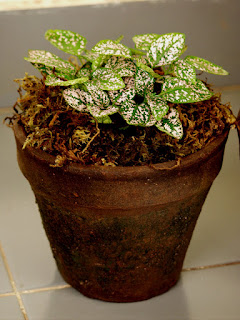 I bought myself some new plants ... the 'Polka Dot Plants'(Hypoestes phyllostachya) ... I am in love... they are simply beautiful ... the splash of color and how fast they grow... I am trying to read up all I can ... about these beauties...and I am so excited to share it with all the readers.
I bought myself some new plants ... the 'Polka Dot Plants'(Hypoestes phyllostachya) ... I am in love... they are simply beautiful ... the splash of color and how fast they grow... I am trying to read up all I can ... about these beauties...and I am so excited to share it with all the readers.The H. phyllostachya ... belongs to the Family... Acanthceae. It is believed to be a native of Madagascar. Normally, you can expect it to grow to a hight of 30 inches ... but you can also find smaller varieties(hybrids I guess).
 The polka dot plant ...is an ornamental plant ... it makes a great house plant ... and enjoys indirect sunlight... making it a great choice for shade gardens. Though bright indirect sunlight is ideal ... it is said to tolerate some bit of sun as well. The lovely burst of colored leaves ...can bring cheer where flowers may find difficulty growing. Faint memories remind me of my father using them as a hedge and as borders around flower beds.
The polka dot plant ...is an ornamental plant ... it makes a great house plant ... and enjoys indirect sunlight... making it a great choice for shade gardens. Though bright indirect sunlight is ideal ... it is said to tolerate some bit of sun as well. The lovely burst of colored leaves ...can bring cheer where flowers may find difficulty growing. Faint memories remind me of my father using them as a hedge and as borders around flower beds.Normally these plants are bushy ...but you may find your plant to grow longer stems and spread out leaves...making it look gangly... all you need to do it keep pinching it back.Though as the plant matures over time you will need to replace it... it looses its bushiness , as the maturer stems begin to show more. The polka dots ... also give out lilac flowers which grow on long shoots or racemes...they may be cute ... though not as spectacular as the leaves.Flowering will probably be seen in summer months.
 You may find some of these cultivars in your local nurseries...
You may find some of these cultivars in your local nurseries...-‘Carmina’ has bright red splotches on the leaves.
-‘Confetti’ series plants are smaller (8 inches) but more vigorous growers than other cultivars, so they fill in more quickly in the landscape. The five separate colors include white, pink, red, carmine rose and burgundy red; they are often offered together as a mix.

-‘Pink Brocade’ is mottled with pink spots.
-‘Pink Dot’ has attractive pink spots.
-‘Purpuriana’ has purplish leaves.
-‘Splash’ series has large blotches of contrasting color in pink, red, rose or white.
-‘Wit’ offers marbled white leaves.
(I found this information about different cultivars from a paper by Susan Mahr,University of Wisconsin,...thanks Susan)
Watering -Spraying or misting... brings out the best in color of the leaves if the sunlight is right. When watering the soil do allow some bit of drying (not completely) before your next watering.
Pests and Diseases - the Hypoestes... is considered quite a hardy plant... but can get powdery mild dew and root rot. As for pests look out for aphids ... mealy bugs.
Propagating - Seeds and cuttings (cuttings can also root in water or the traditional way of planting them in soil).

